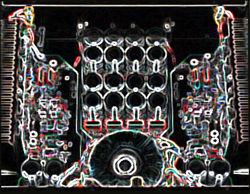
MATTERS OF EFFICIENCY
Efficiency can be measured several ways, but the official definition of efficiency is power out divided by power in.
The problem arises when choosing a power level for measuring efficiency. The efficiency of an amplifier changes over frequency, amplitude, temperature, and even signal history.
In addition, “real source material,” such as music and speech, are rarely used to measure efficiency due to their transient nature, although one would think this is most important.
Efficiency is typically measured at maximum power output, where it’s usually at a maximum, and is related to efficiency during playback of real signal material.
For example, if Amplifier A has higher efficiency at maximum power than Amplifier B, then Amplifier A will likely be more efficient than Amplifier B when playing real source material.
However, there are cases where higher efficiency at maximum power doesn’t translate to higher efficiency while playing actual source material. In fact, the choice of source material can make significant differences in realized efficiency. Efficiency at low signal levels is largely controlled by quiescent (“quiet”) power loss, which also plays an important role in “real world” efficiency.
With all this said, it’s regrettable that we must generalize with maximum power efficiencies, but it helps contain the scope of the discussion to a manageable level.
Let’s suppose we are comparing two amplifiers – Amplifier A is 50 percent efficient and Amplifier B is 100 percent efficient. This means that Amplifier A wastes as much power (as heat) as it delivers to the load, and Amplifier B wastes no power at all, generating no heat and delivering everything it consumes directly to the load.
Let’s also suppose these are 100-watt amplifiers, and that we want the power supply to be able to run 100 watts through the amplifier to the load indefinitely. There are tricks often played with the power supply’s actual capability in the audio realm, but we will assume here that none of those tricks are being used.
Amplifier A requires a 100-watt heat sink, and Amplifier B requires no heat sink. (A 100-watt heat sink is quite large, and has significant weight.) In addition, Amplifier A requires a 200-watt power supply as opposed to Amplifier B’s 100-watt supply. That’s twice the power to drive the same load at the same power, plus a large heat sink, all so we can throw heat off into the air!
As we approach 100 percent efficiency, heat sinks and power supplies shrink, enabling more compact and lighter products.
IN SESSION
Class-B topology is the simplest to explain. Refer again to Figure 1 – QT and QB are used to direct current from the voltage rails (+V and –V) into, or out of, the load. A drive circuit controls the transistors.
Assume the desired output is a voltage, and the current through the transistor, multiplied by the voltage across it, is power, dissipated as heat. This power is wasted energy because it doesn’t contribute to driving the load.
The heat generated is an undesirable side effect of this circuit topology and must be dissipated into the air (by a heat sink). In most cases, the desired output voltage is only a fraction of the voltage rails.
The remaining voltage (from the rail to the output) is across the transistor that is currently conducting. The top transistor conducts during positive voltage output, and the bottom transistor conducts during negative voltage output.
The current, in the case of a resistive load, is a multiple of the output voltage, resulting in large power losses. It all boils down to another shortcoming of this class.
